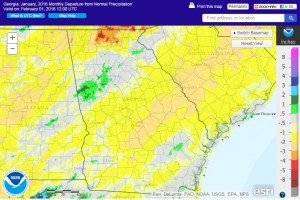Weather stations across Georgia recorded temperatures that were mainly one to two degrees below normal in January. Most stations also reported drier than normal conditions for the month, although Atlanta and Alma were exceptions to this pattern.
Temperatures across the state were below normal in January. In Atlanta, the monthly average temperature was 42.4 degrees F (0.9 degrees below normal), in Athens 42.0 degrees (1.5 degrees below normal), Columbus 45.5 (1.7 degrees below normal), Macon 44.9 (1.4 below normal), Savannah 48.4 (1.1 below normal), Brunswick 50.6 (0.9 below normal), Alma 70.2 (1.1 below normal), Augusta 44.2 (1.2 below normal), Albany 48.1 (1.2 below normal), Alma 48.6 (2.1 below normal), Brunswick 50.6 (0.9 below normal), Rome 39.5 (1.6 below normal) and Valdosta 50.1 (0.3 degrees below normal). However, combined with the record-setting warm January temperatures, the winter so far is still well above normal in temperature.
Two record low maximum temperatures were set in January. Savannah and Alma both set records on January 23. Savannah reported a new low max of 40 F, beating the old record of 41 F and Alma reported a low max of 42 F, beating the old record of 42 F. Both of the old records were from 2003.
The thermograph from Atlanta above shows how much above normal the end of December was, and how much closer to normal January was (normal is the green band in the middle of the thermograph).
The rainiest parts of Georgia were the southwest corner and a band that stretched across the northern part of the state, including the Atlanta metropolitan area.
The highest monthly total precipitation from National Weather Service reporting stations was 5.14 inches in Atlanta (0.94 inches above normal) and the lowest was in Augusta at 1.66 inches (2.25 inches below normal). Athens received 3.68 inches (0.37 inches below normal), Columbus received 3.20 inches (0.65 below normal), Macon 2.52 inches (1.72 below normal), Savannah 3.13 inches (0.56 below normal), Alma 4.59 inches (0.33 above normal), Brunswick 3.15 inches (0.07 below normal), Rome 3.37 inches (1.45 below normal), Valdosta 3.89 inches (0.68 below normal), and Albany 3.66 inches (1.16 inches below normal).
The highest verified single-day rainfall from CoCoRaHS stations was 2.82 inches near Riverdale in Clayton County on January 22, followed by 2.65 inches received near Gainesville in Hall County on the same date. The highest monthly total rainfall was 6.85 inches, observed near Dillard in Rabun County, followed by 6.69 inches near Cairo in Grady County. The Dillard observer also had the highest snowfall for the month, with a total of 8.5 inches reported.
No severe weather was reported in January in Georgia, although I received some unofficial reports of high winds during the month.
Rain early in the month caused problems with flooding in some locations. A mail carrier’s vehicle was swept away by a flooding creek in Oglethorpe County after the substitute mail carried made a wrong turn and drove across a flooded roadway. Fortunately, the carrier was rescued after a couple of hours trapped in the vehicle.
The outlook for February and early spring shows that the continuation of El Nino-like conditions are likely to continue, including cooler than normal temperatures and wet conditions, particularly in southern Georgia. This is likely to mean wet soil conditions for farmers going into the planting season. After the El Nino dies away, a swing to La Nina is expected by late summer, which will increase the chance of dry conditions later in the growing season. The Atlantic tropical season is also expected to be more active than usual in the absence of an El Nino.
For more information please see the “Climate and Agriculture” blog at https://site.extension.uga.edu/climate/ or visit our new web page at https://www.gaclimate.org. Please feel free to email your weather and climate impacts on agriculture to share on the blog to pknox@uga.edu.



